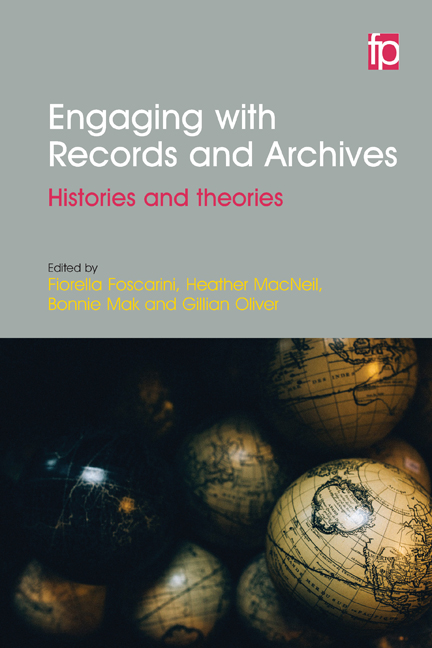Book contents
- Frontmatter
- Frontmatter
- Editors and contributors
- Editors’ introduction
- PART 1 RETHINKING HISTORIES AND THEORIES
- 1 Moving the margins to the middle: reconciling ‘the archive’ with the archives
- 2 Organisms, skeletons and the archivist as palaeontologist: metaphors of archival order and reconstruction in context
- 3 ‘Records in context’ in context: a brief history of data modelling for archival description
- 4 Mapping archival silence: technology and the historical record
- 5 Hidden voices in the archives: pioneering women archivists in early 20th-century England
- PART 2 ENGAGING RECORDS AND ARCHIVES
- Index
4 - Mapping archival silence: technology and the historical record
from PART 1 - RETHINKING HISTORIES AND THEORIES
Published online by Cambridge University Press: 08 June 2018
- Frontmatter
- Frontmatter
- Editors and contributors
- Editors’ introduction
- PART 1 RETHINKING HISTORIES AND THEORIES
- 1 Moving the margins to the middle: reconciling ‘the archive’ with the archives
- 2 Organisms, skeletons and the archivist as palaeontologist: metaphors of archival order and reconstruction in context
- 3 ‘Records in context’ in context: a brief history of data modelling for archival description
- 4 Mapping archival silence: technology and the historical record
- 5 Hidden voices in the archives: pioneering women archivists in early 20th-century England
- PART 2 ENGAGING RECORDS AND ARCHIVES
- Index
Summary
RECENT THEORIZATIONS OF archival silence signal a heightened and expanding concern with information that is lost, concealed, destroyed or simply not available for scholarly use. For a dynamic and interdisciplinary group of artists, scholars and theorists, archival silence serves as a productive metaphor as well as a kind of shorthand to refer to gaps, omissions and distortions in the historical record. Like the term ‘archive’ itself, ‘archival silence’ has a certain elasticity and ambiguity that lends itself to theoretical speculation and manipulation. As digital capacity fosters the expansion of the archive, archival metaphor and archival theory proliferate. And as our access to the archive becomes more dependent upon the technologies of the interface, scholars exhibit increasing concern about the impact of digital affordances and constraints on recordkeeping, research and artistic production. Because digital technologies introduce a variety of new elements – material, social and technological – into questions of archival access, they vastly expand the possibilities for both creating and redressing archival silence.
As digital archives are techno-cultural artefacts, developments in the field of science studies can provide insight into the interdependence and coevolution of the social, cultural and material factors shaping archival access. By the 1990s, Donna Haraway (1991a) had initiated a rethinking of the complex relationship between the human and the non-human. Haraway and other science studies scholars describe instruments and devices as complex assemblages of human and non-human elements. Karen Barad (2006), Bruno Latour (1999) and others have helped us to see how machine and human agents form tightly linked networks that must be understood as dynamically integrated wholes. These scholars view physical matter and social meaning as so deeply intertwined that they cannot be understood separately. They believe that disciplinary boundaries may serve as impediments to understanding both technology and culture. Digital archives lend themselves to this kind of exploration of the entanglement of matter and meaning, content and device, human and machine elements. Digital archives are the product of multiple mutually conditioning factors, including the intentions of document creators, the professional practices of librarians and archivists, the structure of archival institutions, the behaviour of corporate content owners, the judgements of computer designers and the properties of the materials used in the production of digital infrastructure (Manoff, 2015).
- Type
- Chapter
- Information
- Engaging with Records and ArchivesHistories and Theories, pp. 63 - 82Publisher: FacetPrint publication year: 2016
- 4
- Cited by



